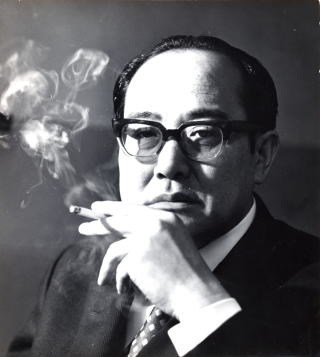- Akimitsu Takagi
Infobox Writer
name = Akimitsu Takagi

caption = Takagi Akimitsu
birthdate = birth date|1920|9|25|df=y
birthplace = Aomori,Japan
deathdate = death date and age|1995|9|9|1920|9|25|df=y
deathplace =Tokyo ,Japan
occupation = Writer
genre =crime fiction ,science fiction nihongo|Akimitsu Takagi|高木 彬光|Takagi Akimitsu|extra=25 September ,1920 –9 September ,1995 , was thepen-name of a popular Japanesecrime fiction writer inShowa period Japan . His real name was Takagi Seiichi.Biography
Takagi was born in Aomori City in
Aomori Prefecture in northern Japan. He graduated from the Daiichi High School (which was often abbreviated to "Ichi-ko") andKyoto Imperial University , where he studiedmetallurgy . He was employed by theNakajima Aircraft Company , but lost his job with the prohibition on military industries in Japan afterWorld War II .On the recommendation of a fortune-teller, he decided to become a writer. He sent the second draft of his first detective story, the "Tattoo Murder Case", to the great mystery writer
Edogawa Ranpo , who recognized his skill and who recommended it to a publisher. It was published in 1948.He received the "Tantei sakka club sho" (Mystery Writer Club Award) for his second novel, the "Noh Mask Murder Case" in 1950.
Takagi was a self-taught legal expert and the heroes in most of his books were usually
prosecutor s orpolice detective s, although the protagonist in his first stories was Kyosuke Kamizu, an assistant professor atTokyo University .Takagi explored variations on the
detective novel in the 1960s, including historical mysteries, picaresque novels, legal mysteries, economic crime stories, andscience fiction alternate history .In "The Informer" (1965), a former
Tokyo stock exchange worker who is fired because of illegal trades. A subsequentstock market crash means that he has no hope of returning to his old career and therefore he accepts a job from an old friend even though he eventually discovers that the new firm he works for is really an agency forindustrial espionage . The plot is based on actual events.He was struck by
stroke several times since 1979, and died in 1995.Bibliography
* "Tattoo Murder Case" (1948) (刺青殺人事件)
* "Noh Mask Murder Case" (1949) (能面殺人事件)
* "House of Spell" (1949) (呪縛の家)
* "Enchantress"s Lodge" (1949) (妖婦の宿)
* "Crime in my Ichi-Ko days" (1951) (我が一高時代の犯罪)
* "Why Has the Doll Been Killed" (1955) (人形はなぜ殺される)
* "Mystery of Genghis Khan" (1958) (成吉思汗の秘密)
* "People Gathering like Ants" (1959) (人蟻)
* "Blind Spot in Broad Daylight" (1960) (白昼の死角)
* "Destructive Justice" (1961) (破戒裁判)
* "Prosecutor Saburo Kirishima" (1964) (検事 霧島三郎)
* "The Informer" (1965) (密告者)
* "Honeymoon to Nowhere" (1965) (ゼロの蜜月)
* "Combined Fleet Has Won at Last" (1971) (連合艦隊ついに勝つ)
* "Mystery of Yamataikoku" (1973) (邪馬台国の秘密)
* "Mystery of the early Japanese Emperors" (1986) (古代天皇の秘密)
* "Seven Lucky Gods Murder Case" (1987) (七福神殺人事件)
* "Goodbye Mask" (1988) (仮面よ さらば)References
* Takagi, Akimitsu. "Honeymoon to Nowhere". Soho Crime (1999). ISBN 1569471541.
* Takagi, Akimitsu. "The Informer." Soho Crime (2001). ISBN 1569472432.
* Takagi, Akimitsu. "The Tattoo Murder Case". Soho Crime (1999). ISBN 1569471568.
Wikimedia Foundation. 2010.
